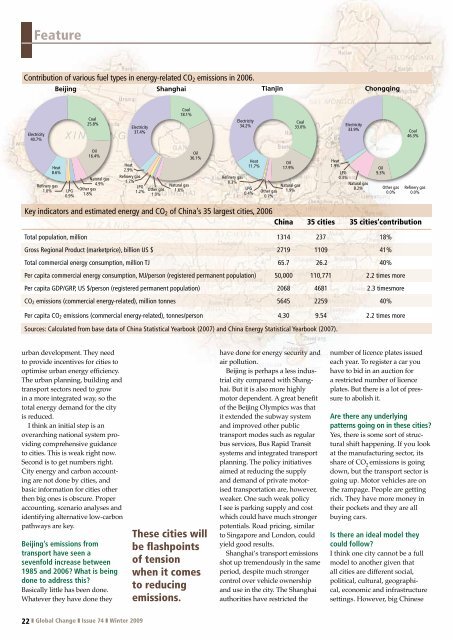Planetary boundarIes
Planetary boundarIes
Planetary boundarIes
You also want an ePaper? Increase the reach of your titles
YUMPU automatically turns print PDFs into web optimized ePapers that Google loves.
Feature<br />
Contribution of various fuel types in energy-related CO2 emissions in 2006.<br />
Key indicators and estimated energy and CO2 of China’s 35 largest cities, 2006<br />
China 35 cities 35 cities’contribution<br />
Total population, million 1314 237 18%<br />
gross Regional Product (marketprice), billion uS $ 2719 1109 41%<br />
Total commercial energy consumption, million TJ 65.7 26.2 40%<br />
Per capita commercial energy consumption, MJ/person (registered permanent population) 50,000 110,771 2.2 times more<br />
Per capita gDP/gRP, uS $/person (registered permanent population) 2068 4681 2.3 timesmore<br />
CO2 emissions (commercial energy-related), million tonnes 5645 2259 40%<br />
Per capita CO2 emissions (commercial energy-related), tonnes/person 4.30 9.54 2.2 times more<br />
Sources: Calculated from base data of China Statistical yearbook (2007) and China Energy Statistical yearbook (2007).<br />
urban development. They need<br />
to provide incentives for cities to<br />
optimise urban energy efficiency.<br />
The urban planning, building and<br />
transport sectors need to grow<br />
in a more integrated way, so the<br />
total energy demand for the city<br />
is reduced.<br />
I think an initial step is an<br />
overarching national system providing<br />
comprehensive guidance<br />
to cities. This is weak right now.<br />
second is to get numbers right.<br />
city energy and carbon accounting<br />
are not done by cities, and<br />
basic information for cities other<br />
then big ones is obscure. Proper<br />
accounting, scenario analyses and<br />
identifying alternative low-carbon<br />
pathways are key.<br />
Beijing’s emissions from<br />
transport have seen a<br />
sevenfold increase between<br />
1985 and 2006? What is being<br />
done to address this?<br />
Basically little has been done.<br />
Whatever they have done they<br />
22 ❚ Global Change ❚ Issue 74 ❚ Winter 2009<br />
these cities will<br />
be flashpoints<br />
of tension<br />
when it comes<br />
to reducing<br />
emissions.<br />
have done for energy security and<br />
air pollution.<br />
Beijing is perhaps a less industrial<br />
city compared with shanghai.<br />
But it is also more highly<br />
motor dependent. a great benefit<br />
of the Beijing olympics was that<br />
it extended the subway system<br />
and improved other public<br />
transport modes such as regular<br />
bus services, Bus Rapid Transit<br />
systems and integrated transport<br />
planning. The policy initiatives<br />
aimed at reducing the supply<br />
and demand of private motorised<br />
transportation are, however,<br />
weaker. one such weak policy<br />
I see is parking supply and cost<br />
which could have much stronger<br />
potentials. Road pricing, similar<br />
to singapore and london, could<br />
yield good results.<br />
shanghai’s transport emissions<br />
shot up tremendously in the same<br />
period, despite much stronger<br />
control over vehicle ownership<br />
and use in the city. The shanghai<br />
authorities have restricted the<br />
number of licence plates issued<br />
each year. To register a car you<br />
have to bid in an auction for<br />
a restricted number of licence<br />
plates. But there is a lot of pressure<br />
to abolish it.<br />
Are there any underlying<br />
patterns going on in these cities?<br />
Yes, there is some sort of structural<br />
shift happening. If you look<br />
at the manufacturing sector, its<br />
share of co 2 emissions is going<br />
down, but the transport sector is<br />
going up. Motor vehicles are on<br />
the rampage. People are getting<br />
rich. They have more money in<br />
their pockets and they are all<br />
buying cars.<br />
Is there an ideal model they<br />
could follow?<br />
I think one city cannot be a full<br />
model to another given that<br />
all cities are different social,<br />
political, cultural, geographical,<br />
economic and infrastructure<br />
settings. however, big chinese

















